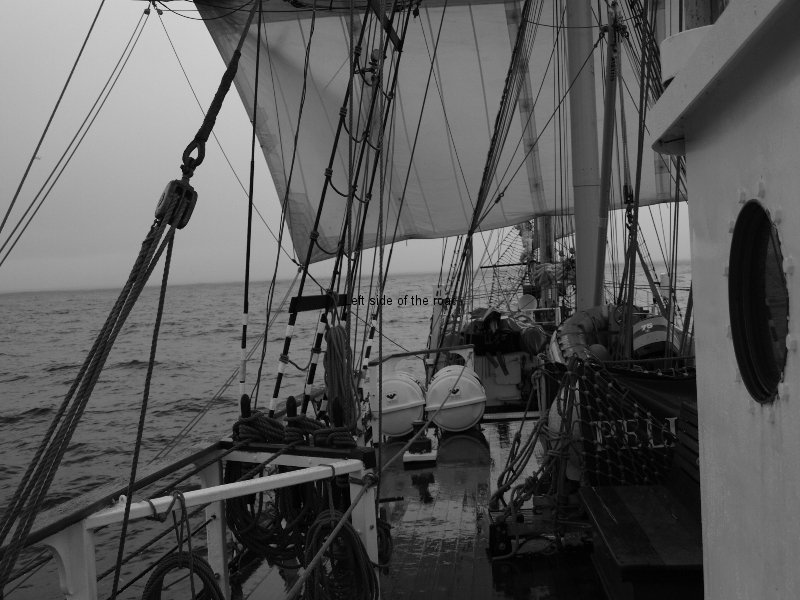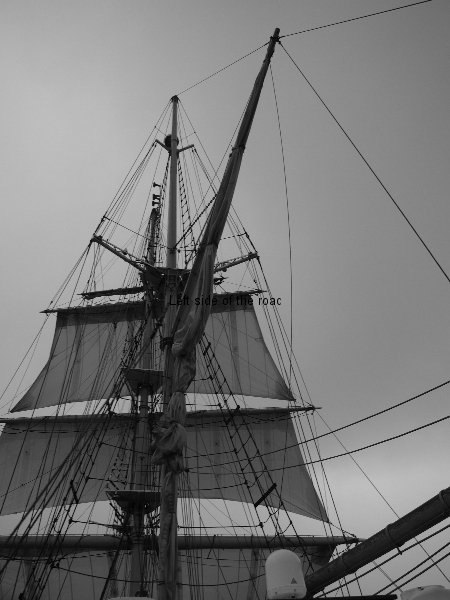
A tall ship lists to starboard during a storm in the Bermuda Triangle
More on sailing on a tall ship
It would have been almost impossible to sail in the Atlantic in February without encountering some bad weather and we had to deal with our first storm on the 17/18th February, as we passed through the Bermuda Triangle.
After a couple of weeks sailing around the islands of the southern Caribbean it was time to start the long journey back to the UK. At first we remained with the calm we were used to and could be on deck at four in the morning in shorts and t-shirts, so benign was the weather.
But this couldn’t last. Heading north, especially at this time of year (it was the middle of February and that’s still the winter in the northern hemisphere) we were bound to hit something different. And on the 17th we did. We had been motoring along, getting no assistance from the wind, when we bumped into a gale, the bottom end of a system that had been dumping a lot of snow along the eastern seaboard of the United States and creating havoc in the seas to the north.
It was the first storm of the journey (we were to have 4 or 5 more before the end) so for those of us not used to sailing it was the first opportunity to see what the sea can do when it’s angry.
One thing I was to learn very quickly was that it’s difficult to capture, either with video or still camera, the sensation of a storm on a boat. The vessel responds to the waves in the way that it has been designed to do, which is amazingly well. The swell might be mountainous but the dance that the ship does to keep itself afloat seems to mitigate the storm’s force.
If you think about it, all the images you might have seen in films (which in themselves are a false reality) of storms, that make you wonder how the ship can survive, are taken off and away from the vessel itself. The small ship gets dwarfed by the huge, killer waves, but you only get that perspective from a distance which is impossible to capture if you are on board. In the middle of the Atlantic there’s no one out there to take pictures of your progress. The element of threat and danger in a film is created on board by someone throwing buckets of water at the cast, trying to give the impression that the sea wants to invade the man-made environment. But I learnt during the storm of the 17th – 18th February that the reality is somewhat different.
And recent technology goes against you when you want to capture the ominous colour of the water. I now know that digital cameras like blue and those black, threatening waves take on a less threatening aspect through a camera lens.
If you want to get a very short (only 30 seconds of a 30 hour storm) impression of what it was like click here for a link to a video I posted on YouTube.
FORECAST
Shipping Forecast issued at 06.00 UCT, 17th February 2013
General Synopsis: Bad news
Sea Area: Bermuda Triangle
Wind Direction: All the wrong way
Wind Speed: 35 knots, gusting to 50, Gale Force 8 to 9
Visibility: 8 miles – though nothing to see but sea
Precipitation: Nil – we hope
Chances of Mysterious Disappearance: Low to non-existent
Barry Manilow: Severe

The port side during the storm
SOUND
ventilators’ whistle and hum drowned by the ominous wind’s howl
foaming and fizzing sea, impassive still, uncaring, truly the cruel sea
breaking waves splash on deck, buckets of seawater elicit curses from the drenched
flapping, snapping, cracking sails indicate the wrong sort of wind
squeaking, straining ropes on clunking pulleys fight against the elements
grating of the bearings on the helm tell of the effort needed this day
no talking, gales kill the art of conversation, apart from nervous banter
ship’s bell, tolling for us all, so no need to ask
thump of the ship’s bow into sea and the clank of the loose anchor against the ship’s side
radio transmission of May Day calls, one Canadian fishing vessel lost a thousand miles away
below galley utensils play an impromptu symphony
plastic cups clatter in their purpose made niches trying to escape
in cabins restless tossing and turning replaces snoring
prayers being said in muted tones, atheists finding faith too late
LIGHT
ship’s lights, white, red and green, tell others what and where we are
grey turns to red on the heading indicator, hypnotising the helm after half an hour
lights in the wheelhouse, white for the log, red for the night
below decks portholes illuminate the foam
red lamp for port reflects momentarily on the spray, indicating danger?
the eerie green on the starboard side reminds us of the unworldly nature of the journey
high white mast light says we’re a vessel under power, sad admission for a sailing ship
moonlight, young first quarter, weak, red, low, short duration, shrouded in clouds – sometimes
pools of stars amongst the clouds, faint, their serenity belies the storm below
beyond the rails the dark abyss of the deep
torch to read temperature, hourly ritual unaffected by the storm
red flashing warning light, but it’s a false alarm, only the bilge
dark apparitions, reminiscent of Carpenter’s Fog, with their slow, unnatural gait, indicate the end is near
time for bed, to sleep, perchance to dream (or lie in the cold, wet arms of a nightmare)









